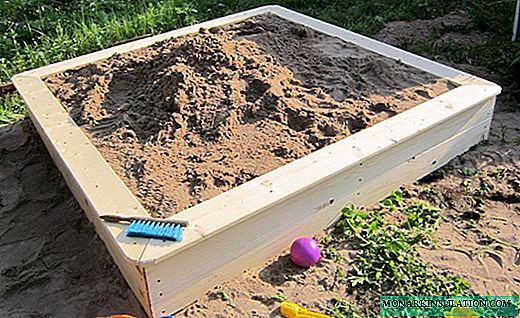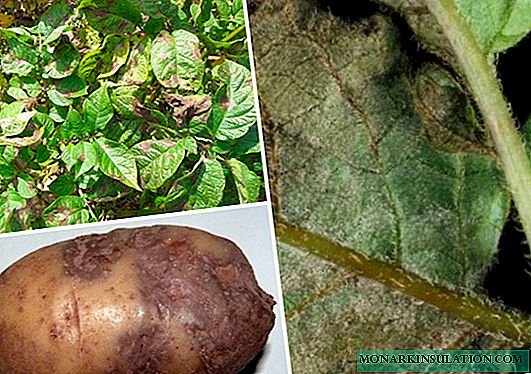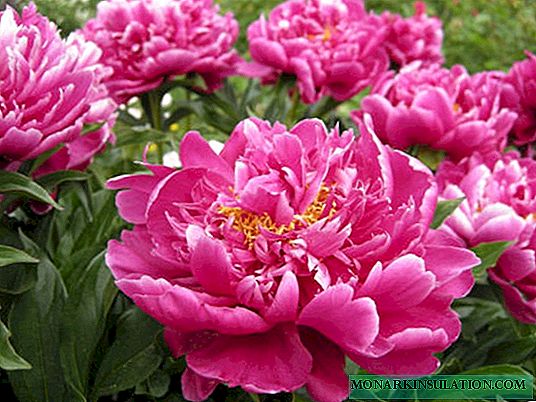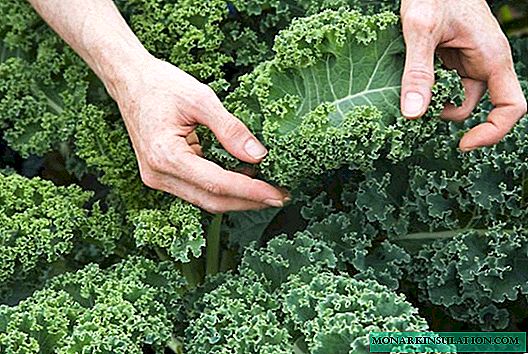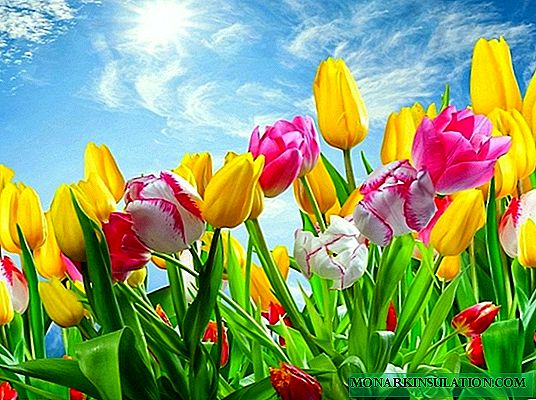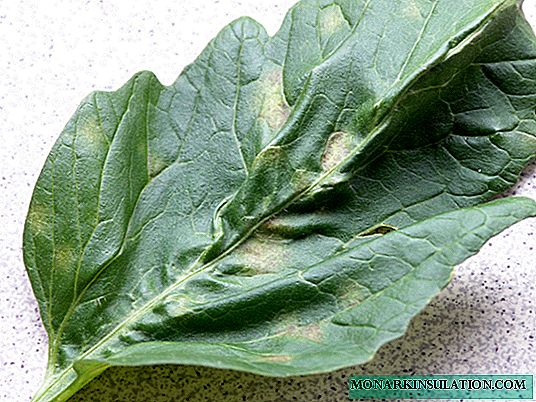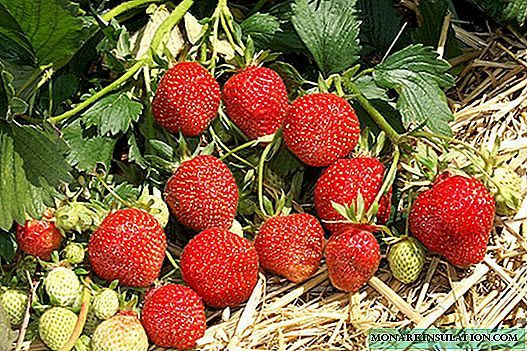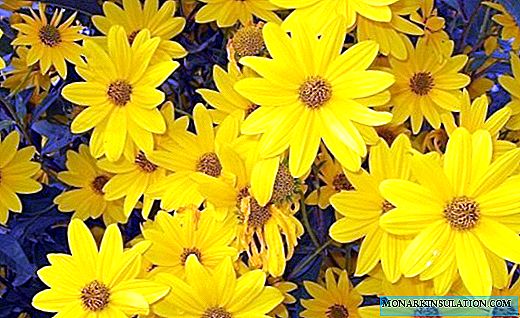Heliopsis is a bright unpretentious flower that looks like many small suns. Lush bushes bloom early and gradually completely covered with buds. During flowering, the sunflower fills the garden with a pleasant tart aroma that attracts butterflies and honey insects.

Description
Heliopsis is a perennial herb of the Astrov family. Its homeland is central and North America, from where it spread throughout most of the globe, found from the Caucasus to Siberia. In the genus, there are more than 10 different varieties and several plant hybrids.
Grassy erect stems have several branches, they are quite resistant to wind and do not require garter. The surface of the stem is smooth, but a slight roughness is observed in the upper part. The height of an adult bush ranges from 70 cm to 1.6 m. The color of leaves and shoots varies from light green to a saturated dark shade. Variegated varieties with white veins are found.
The leaves are ovoid or oval with a pointed outer edge and serrated sides. The foliage is located opposite or along short petioles along the entire stem length.














Flowers in the form of baskets are simple (single-row) and complex (lush). The color of the petals is most often yellow, sometimes with a red base. Petals are long and elongated, have a pointed or jagged edge. The core is magnificent, tubular, happens yellow, claret or brown. The diameter of one open flower is 5-10 cm. Typically, flowers on individual pedicels are collected in thick panicles of inflorescences.
Flowering begins in mid-summer and continues until frost. Seeds ripen in a small box, from which they easily fall out. The shape of the seeds resembles sunflower seeds.
Varieties
The most common among flower growers is heliopsis sunflower. Perennial with bare branched shoots forms a bush up to 1 m tall. The leaves are sparse, which makes the bush appear semi-transparent. Flowers on tall stems are suitable for cutting and use in bouquet compositions.
Bright yellow baskets reach a diameter of 8-9 cm and are collected in inflorescence. On one stem, 3-5 buds are blooming at the same time. Blossom begins in late June for 2-3 months.
Breeders have bred several varieties of heliopsis, which allow you to make the optimal composition in the garden. The most interesting are:
- Asahi - on the bushes up to 75 cm high, semi-double flowers bloom with an invisible core, similar to large golden balls;
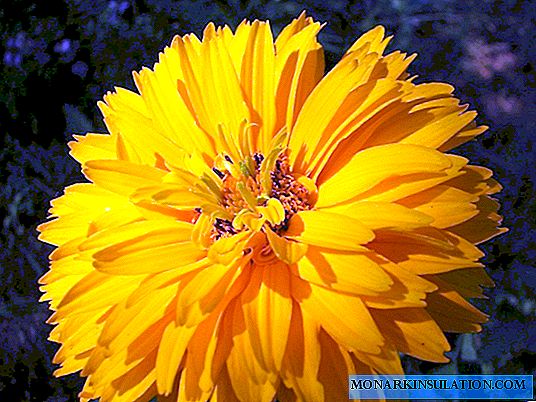 Heliopsis Asahi
Heliopsis Asahi - Summernigth - differs in darker coloring of foliage and claret stalks; the core of simple baskets is brown;
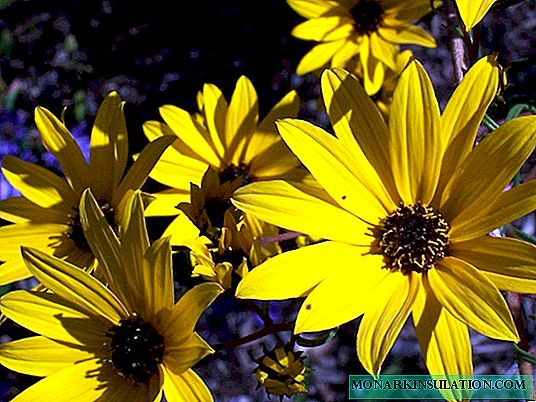 Heliopsis SummerNigth
Heliopsis SummerNigth - Goldgrenherz - Terry lemon baskets with a greenish middle open on tall stems.
 Heliopsis Goldgrenherz
Heliopsis Goldgrenherz
Also popular rough heliopsis. Its stem, petioles and the leaves themselves are covered with hard, even prickly villi. Bushes of this variety are higher than the previous one and are 1.5 m. Foliage is fixed on the stem opposite, on small petioles. Baskets of flowers are slightly smaller, up to 7 cm.

Interesting not only in bright colors, but also in foliage, heliopsis variegated. The first known variety was LoraineSunshine. Smaller bushes (up to 90 cm) are covered with almost white foliage. Leaf plates retained only short green veins. Baskets of flowers are thick, bright yellow.

There are several varieties of variegated form:
- Summergreen - bush 70-90 cm high, bright yellow flowers with an orange core;
- Summerpink - pink colors are present in the color of the leaves, and yellow petals frame the lush orange core;
- Sunburst - medium-sized bushes with large baskets, green leaves with white stripes.
Breeding
Heliopsis is propagated by dividing a bush or sowing seeds. The plant tolerates frosts well, therefore, in a temperate climate, seeds are sown in the fall, before the onset of frost. Shoots appear in early spring, and bright flowers form in the summer of the first year.

For planting, fertile or well-fertilized soil is needed. The use of compost and mineral dressings (for example, superphosphate) is optimal. You can pre-grow seedlings from seeds. For seedlings to be friendly, for 2-3 weeks the seeds are stratified in a refrigerator or other room with an air temperature of + 4 ° C. In March, seeds are placed in the soil to a depth of 1 cm. A light peat substrate is used. It is recommended to immediately maintain a distance between crops of 10-15 cm. The container is kept in a warm, well-lit place until four true leaves appear. Then the seedlings dive into individual pots and begin to harden at a temperature of + 14 ... + 16 ° C. In late May, you can plant seedlings in a permanent place.

You can divide bushes. Thickets 3-4 years old or more are suitable for this. In the autumn, the bush is dug up and divided into smaller ones. It is recommended to fertilize or renew the soil before planting. Between young plants in the garden keep a distance of at least 40 cm.
Variegated varieties propagated by cuttings. This method is more troublesome and rarely used, but allows you to save varietal properties. Cuttings are cut from mid-summer and rooted in a fertile, well-drained substrate in a pot. Transplanted into the open ground next spring.

Cultivation and care
Heliopsis is very unpretentious. This southern plant easily adapts to extreme heat and drought. Even with insufficient watering, it does not dry out, but begins to bloom less. The plant is very photophilous, therefore, open areas are chosen for planting.
Good soil drainage and protection against drafts should be taken care of. For air access to the roots, weeding should be carried out periodically. Once every 3-4 weeks, the plant is fertilized with organic or mineral fertilizers. In the first year of life, fertilizing is not enough, since there are still many nutrients in the soil.
To increase the number of lateral shoots, the stems are regularly pinched. The bushes grow greatly and acquire a sprawling, spherical shape. To raise the creeping processes, you can use frames or other support.

The plant tolerates pruning well to form a beautiful bush and use flowers in bouquets. So that young flowers form in the place of wilted, dry buds are cut. In autumn, the entire green part is cut to ground level. The roots are resistant even to severe frosts and do not require shelter.
In rare cases, round brown spots can be seen on the leaves or stalks, indicating rust damage. A white-gray coating on the foliage indicates a powdery mildew disease. Sick shoots ruthlessly cut and burn. To prevent fungal diseases in spring, the earth and young shoots are sprayed with a solution of copper sulfate and foundationazole.
Although the bush can grow in one place for several decades, the rhizome grows strongly and heliopsis occupies a significant area. Transplanting and dividing the root every 5-7 years helps to cope with this.

Using
Heliopsis is actively used for making bouquets. Its bright flowers will stand in a vase for more than 10 days and will not go unnoticed. Lush bushes are suitable for decorating flower beds and arranging bright accents in the garden. You can create both monochromatic (with marigolds, rudbeckia, a succession), and multicolored (with bells, cornflowers, asters) compositions.





